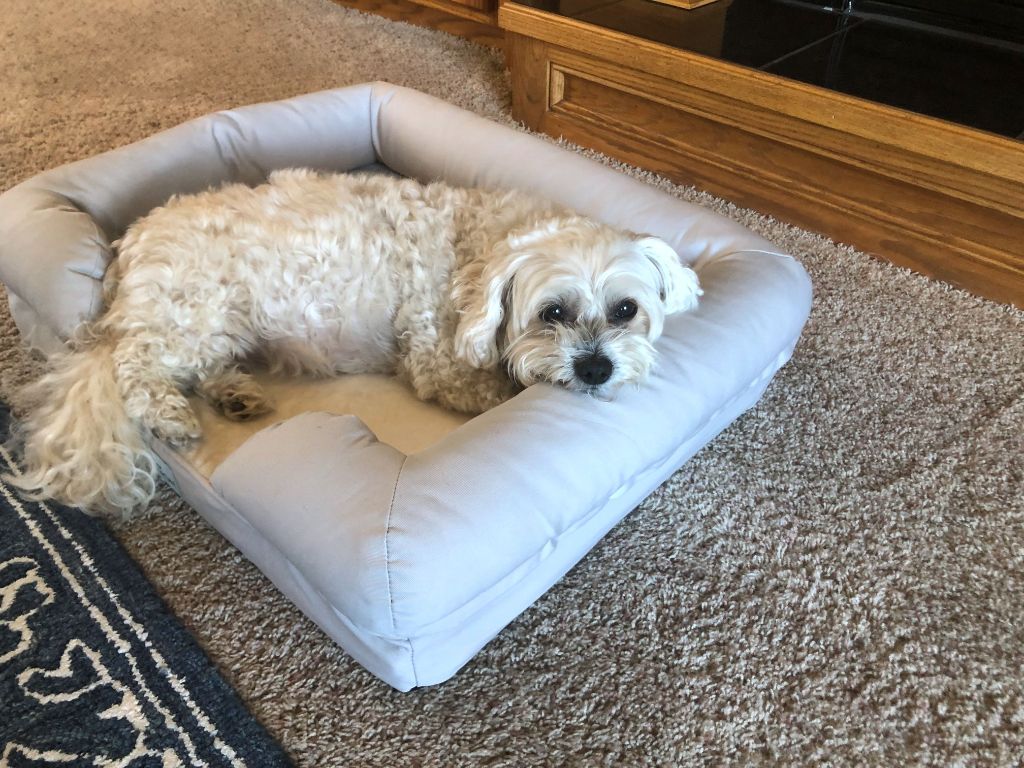Introduction
Walking up and down stairs can be daunting and painful for dogs suffering from arthritis. According to a study by Wright et.al in the Journal of Small Animal Practice, the activities of going up stairs and rising from sitting or lying down were reported as the most difficult for dogs with osteoarthritis, taking the longest time to improve with treatment. With arthritis already causing chronic pain and inflammation in a dog’s joints, the impact and strain from going up and down stairs can exacerbate these symptoms.
For arthritic dogs, stairs put extra stress on already tender joints and can lead to further pain, stiffness and difficulty moving around. While some dogs may power through the pain, long-term use of stairs is likely to accelerate joint degeneration. This highlights the need for pet owners to find ways to manage and minimize their arthritic dog’s stair use.
In this article, we will explore how stairs can aggravate arthritis, provide tips on safer stair use, discuss stair-free exercise options, outline signs that indicate when to stop using stairs altogether, and suggest stair-free living solutions to maintain an arthritic dog’s quality of life. By understanding the joint stress from stairs and how to alleviate it, owners can help their dogs better manage this challenging everyday obstacle.
What is Canine Arthritis?
Canine arthritis, also known as osteoarthritis or degenerative joint disease, is a condition caused by cartilage breakdown in a dog’s joints over time. It results in inflammation, pain, and stiffness in the joints.
Some common symptoms of canine arthritis include limping, difficulty standing up or lying down, stiffness after rest, reduced range of motion, reluctance to jump or climb stairs, and a change in temperament due to pain.
There are several factors that contribute to the development of arthritis in dogs:
- Age – Older dogs are more prone to arthritis as cartilage wears down over time.
- Injury – Damage to joints from ACL tears, fractures, or soft tissue injuries can lead to arthritis.
- Obesity – Excess weight puts more pressure on joints and accelerates cartilage breakdown.
- Genetics – Some breeds like Labradors are genetically prone to hip and elbow dysplasia.

While not curable, various treatments are available to manage pain and improve mobility for dogs with arthritis.
How Stairs Can Aggravate Arthritis
Climbing up and down stairs puts additional pressure on the joints, especially the knees and hips, which can aggravate arthritis symptoms. According to research published in the journal Pain Medicine, patients with knee osteoarthritis experienced significantly decreased stair climbing ability compared to healthy controls (1). The repetitive motion of going up steps flexes the joints, while descending stairs extends the joints. This repeated impact can cause pain, inflammation and faster joint deterioration.
Going downstairs is often more challenging and higher risk for those with arthritis. Muscle weakness or joint stiffness causes difficulty controlling the descent. Falls are more likely to occur going down than up. To mitigate risks, the Arthritis Foundation recommends taking stairs one at a time, holding handrails, and avoiding carrying items when using stairs (2). Planning ahead and using assistive devices like canes or walkers can also provide needed support and stability.
Overall, frequent use of stairs when living with arthritis should be avoided. It’s best to limit climbing to essential tasks, go slowly, rest when needed, and consider alternatives like elevators when possible.
Tips for Managing Stairs
There are several ways to make stairs easier and safer for arthritic dogs. Using ramps or stair lifts can allow dogs to avoid stairs entirely. Ramps distribute the incline over a longer distance, reducing strain on joints. Stair lifts physically carry dogs up stairs in a harness or sling. Both ramps and stair lifts remove the impact and effort of climbing stairs.
For dogs still able to manage stairs, adding carpeting or non-slip stair treads can provide essential traction. Carpeted stairs give paws better grip. Non-slip treads are another option for hardwood or tile stairs. They add texture and rubbery grip to reduce slipping. Proper traction makes climbing and descending stairs much easier on arthritic joints.
Giving dogs pain medication before tackling stairs is another helpful strategy. NSAIDs or other arthritis medication can provide temporary pain relief before a known stair use. This extra pain relief makes moving and climbing much more comfortable for arthritic dogs.
Sources:
https://caninearthritis.org/article/make-stairs-easier-traction/
https://topdoghealth.com/pet-proofing-your-house-for-arthritic-dogs/
Exercising an Arthritic Dog

Proper exercise is crucial for arthritic dogs, as it helps maintain joint flexibility and muscle mass. However, high-impact activities like running and jumping should be avoided. Here are some safer, low-impact exercise options for dogs with arthritis:
Low-impact exercise like leash walking helps improve cardiovascular health while going easy on joints. Start with short, frequent walks and gradually increase duration as your dog’s stamina improves. Swimming and hydrotherapy are excellent forms of exercise, as the water supports the dog’s body weight and reduces pressure on joints. Consult with your vet on options like underwater treadmills or heated hydrotherapy pools in your area (https://www.protexinvet.com/article/419-top-tips-for-exercising-your-arthritic-dog).
Massaging your dog’s joints and muscles can help reduce stiffness and pain. Gently knead areas like the hips, legs and shoulders for 5-10 minutes daily. Always check with your vet first and avoid massaging inflamed or tender areas. Other beneficial touches include range of motion stretches for major joints like the hips, shoulders and back (https://topdoghealth.com/top-3-stretches-for-arthritic-dogs/).
An arthritic dog’s exercise needs to be carefully managed. Focus on building low-impact endurance with leash walks, hydrotherapy and massage. Some activity is crucial, but high-impact exercise should be avoided to protect joints.
When to Avoid Stairs
Ascending and descending stairs can be very challenging and painful for dogs with severe arthritis. There are certain times when it’s best to avoid having an arthritic dog use stairs altogether:
Severe Pain on Stairs: If your dog cries, yelps or shows signs of significant pain when going up or down stairs, it’s best to avoid stairs. The strain on their joints is too much. Carry them or use ramps instead (1).
Difficulty Descending: Arthritic dogs often have more trouble going down stairs than up them. The impact on their joints from descending can cause immense pain. Avoid down stairs if your dog seems unstable or strained (2).
After Surgery: In the recovery period after orthopedic surgery like TPLO or hip replacement, stairs should be strictly off limits. Too much activity on stairs could damage the surgical site or implants (3). Follow your vet’s guidance on when it’s safe to reintroduce stairs.
In general, listen to your dog’s needs. If stairs seem to exacerbate their arthritis pain and instability, find an alternative way to help them access different levels safely and comfortably.
Sources:
(1) https://caninearthritis.org/article/make-stairs-easier-traction/
(2) https://www.handicappedpets.com/blog/dogs-with-arthrits-and-stairs/
(3) https://topdoghealth.com/pet-proofing-your-house-for-arthritic-dogs/
Making Stair Alternatives
There are several ways to provide easier access for arthritic dogs without using stairs. Some options include:

Building outdoor ramps – Constructing gentle sloped ramps using wood or metal is an excellent way to avoid outdoor steps and provide easy access in and out of the home. Ramps should have a non-slip surface and can be decorated to blend in with landscaping.
Blocking stairs – Use baby gates or other barriers to prevent access to stairs inside the home. This forces dogs to use alternate pet-friendly routes that don’t require climbing steps. Just be sure to provide ramps or lifts wherever stairs are blocked off.
Using baby gates – Temporary gates are a quick solution for blocking off specific stairs that are difficult to avoid entirely. They can restrict access to problem areas like tall staircases or basement steps while allowing access to the rest of the home.
With some creativity and carpentry skills, sturdy ramps can be constructed to provide easy, long-term access to a home without forcing dogs to climb stairs. Temporary gates also give some restriction options. The key is limiting stairs whenever possible.
Knowing When It’s Too Much
Even with the best precautions, it’s possible for arthritic dogs to overexert themselves on stairs. As a dog owner, it’s important to watch for signs of overexertion and know when stair use has become too difficult for your dog.
Telltale signs of overexertion include increased limping or stiffness after using the stairs. Your dog may be hesitant to climb up or down stairs again or yelp in pain during or after stair use. Increased limping and hesitancy indicate that the impact and strain of going up and down steps is aggravating your dog’s arthritic joints.
Yelping or crying out while on the stairs is a clear sign your dog is experiencing significant pain and discomfort from arthritis flare ups. The jarring forces of navigating steps worsens inflammation and puts pressure on already aching joints. If your dog vocally expresses pain on the stairs, it means the activity has become too challenging for their current condition.
When you notice these overexertion signs, it’s time to start carrying your dog up and down steps and minimizing stair use. Consult with your vet as well, as adjustments to medication or treatment may be needed if arthritis is worsening. Keep a close eye on your dog and don’t push them to take stairs when it’s causing too much pain and difficulty.
Additional Tips
There are a few additional things you can do to help support an arthritic dog’s health and mobility:
-
Maintain a healthy weight. Carrying extra pounds puts more stress on joints. Keeping your dog at an optimal weight recommended by your vet can really help reduce discomfort. Consult with your vet to determine the right diet and feeding schedule for weight loss if needed.
-
Consider supplements. Glucosamine, chondroitin, turmeric, and omega-3 fatty acids have anti-inflammatory properties and can help relieve arthritis symptoms. Talk to your vet before starting supplements to make sure they are safe and effective for your dog.
-
Try acupuncture. Acupuncture is believed to stimulate natural pain relief by increasing blood flow and immunity. Regular treatments may help reduce inflammation and pain over time. Work with a licensed veterinary acupuncturist to create a treatment plan.
Managing your arthritic dog’s environment, providing comfortable rest areas, doing gentle supervised exercise, and giving joint supplements can all help improve their mobility and quality of life. But be sure to consult your vet if your dog seems to be in significant pain or their mobility is deteriorating.
Conclusion

Canine arthritis can make simple daily tasks more difficult for affected dogs. While stairs are often a necessity for dogs living in homes with multiple levels, they can worsen arthritis symptoms and pain. There are ways for dog owners to help manage their arthritic dog’s use of stairs, such as assisting them up and down stairs, using ramps or slings, and limiting stair use when possible.
With some thoughtful adjustments and care, even dogs with severe arthritis can lead happy and active lives. It’s important for owners to closely monitor their dog’s comfort level with stairs and not overdo it. There are many alternative ways to make sure dogs still get the physical and mental exercise they need. By staying attuned to their dog’s needs and abilities, owners can make the stairs issue manageable while keeping their furry friends comfortable.
With a proactive and compassionate approach, dog owners can help their arthritic pets navigate stairs and enjoy their golden years together. The key is reducing overall strain and impact while still providing activity and enrichment. If managed properly, arthritis doesn’t have to mean the end of playtime and adventures.